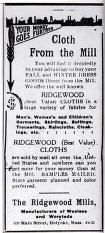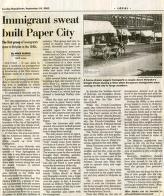|

"Cloth from the Mill" advertisement

"Immigrant Sweat built Paper City" article from Sunday Republican newspaper

"At Work" photo & "History Finds Irish in Holyoke in 1663" from "Irish Heritage Important to Wmass.. in The Republican newspaper

"State of Irish Poor" article from in the Greenfield Gazette and Franklin Herald newspaper

"Holyoke Dam, Holyoke, Mass."
|
Summary and Objective
Students will understand that there was a valid reason why so many Irish people immigrated to the Holyoke, Massachusetts area. Yet, students will also see the hardships and struggles this group of immigrants faced in hopes of a better life. Students will analyze the given primary sources to make a conclusion as to whether they feel the Irish immigration to America, specifically Holyoke,MA was a successful venture for these individuals.
Teaching Plan
Step 1.
Students listen to the read aloud story, "Dreaming of America: An Ellis Island Story" by Eve Bunting. The class discusses the events in the story. Students may make connections to the Pilgrims voyage across the Atlantic to the New World as they left families behind too, for a better life in America. On the classroom map, show students where Ellis Island would be located in relationship to Massachusetts.
Step 2.
The students are paired up to read copies of the article from the Greenfield Gazette and Franklin Herald Newspaper titled, "State of Irish Poor." After reading this article, the class will discuss their findings. What was life like in Ireland in the mid-1800's? What caused the Irish to leave their homeland? Were there dangers associated with this departure?
Step 3.
Students look at the "At Work" primary document that shows immigrants from Ireland building a dam on the Connecticut River for water-power use. Ask the students in the class whether this looks like physically demanding work. After reading the caption, pose the questions: What surprised you about this photograph? Is this easy work? What tells you about the type of work the men are doing? Next, show students the postcard "Holyoke Dam, Holyoke, Mass." that shows the finished dam in use on the Connecticut River. What reaction do they have to this finished image after seeing the first image above? Make a word splash on flip chart paper to show students' thoughts about this monstrous dam built by the Irish immigrants.
Step 4.
Each student will write a letter to a relative taking an Irish immigrant's perspective. In the letter, they will state their concerns about traveling to America and what they will sacrifice and hope to gain by taking this risk. Students share letters on later days of this unit. Letters will be posted on a classroom bulletin board titled, "Irish Immigrants in our Area".
Step 5.
Extension activity: Using the SmartBoard and Internet capabilites, show students examples of water power on YouTube (see address below). This will give students an example of how water power made machines work for a specific purpose, in this case, cutting wood.
Step 6.
Extension activity: The class will do a reading of the article in the collection titled, "Immigrant Sweat Built Paper City." Each student will read a paragraph going around the class meeting area circle. After reading the article, ask students how they feel about this newspaper writer giving the Irish immigrants credit for being a driving force in making paper city a booming industrial center.
Step 7.
Extension activity: Teacher will bring in various cloth samples, showing the variety of cloth used for textiles. Give students a chance to see and feel each sample. Show them the "Cloth from the Mill" advertisement from the Ridgewood Mills in Holyoke, MA that suggests this mill gives you "more for your money." Teacher makes a tally chart to show how many students like each type of cloth. Tell the students that the silk was a popular material used by the Skinner Mill in Holyoke, MA.
Step 8.
Extension activity: Class will take a trip to the Holyoke Heritage Park and the Skinner Museum. While at the park, students see first hand how the dam and canal system caused mills to be powered. Students walk along the water to see the canal and waterway. At Wistariahurst Museum the docents offer students a tour of the Skinner mansion. The students see the servant quarters and how the "boss" of the immigrants lived.
|




